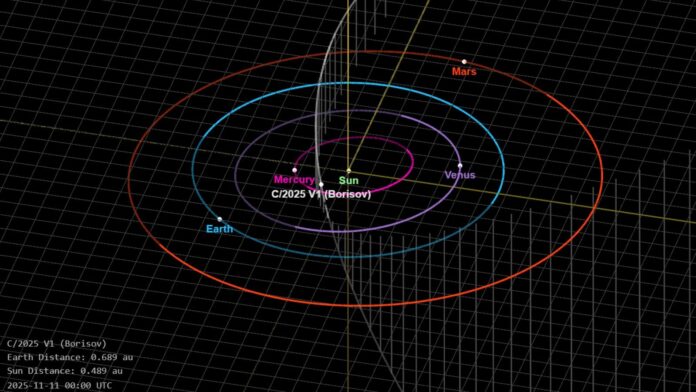A newly discovered comet, C/2025 V1 (Borisov), is making headlines as it nears its closest approach to Earth on November 11th. Found just days earlier by amateur astronomer Gennadiy Borisov, this celestial visitor has sparked excitement and speculation, primarily due to some superficial similarities with the famous interstellar object 3I/ATLAS. However, while intriguing, this connection is likely more coincidence than cosmic kinship.
C/2025 V1 will reach a distance of about 64 million miles (103 million kilometers) from Earth – roughly 270 times farther away than the moon. While faint and invisible to the naked eye, dedicated stargazers with telescopes or binoculars might catch a glimpse of this cosmic traveler in the constellation Virgo just before sunrise. The comet’s apparent magnitude of 13.8 means it requires specialized equipment for observation.
This isn’t Borisov’s first foray into interstellar discovery. He also identified “Comet Borisov,” the second confirmed interstellar object, back in 2019. That comet, like 3I/ATLAS which zipped through our solar system earlier this year, originated from another star system billions of years ago, arriving with incredible speed and a trajectory distinctly different from typical comets.
The shared orbital peculiarities of C/2025 V1 and 3I/ATLAS, particularly their high eccentricity (a very straight trajectory towards the sun), have fueled comparisons. Some, including renowned astrophysicist Avi Loeb, have even labeled C/2025 V1 as a “nearly interstellar object.” However, this classification is somewhat speculative.
Furthering the intrigue, C/2025 V1, like some images of 3I/ATLAS, seems to lack its characteristic tail, further feeding speculation. This has led to theories suggesting that C/2025 V1 could be a probe dispatched by 3I/ATLAS – a concept first proposed by Loeb after the discovery of the interstellar comet.
While intriguing, Loeb himself downplays this notion. The immense distance between the two objects at their closest point (around 140 million miles) makes direct interaction unlikely. He posits that C/2025 V1 most likely originated in the Oort Cloud, a vast reservoir of icy bodies residing far beyond Neptune’s orbit.
As for 3I/ATLAS, it has reappeared after its close encounter with the sun, having reached perihelion (its closest point to the sun) on October 29th. This visit was marked by unusual brightening and even a temporary color shift. It is now receding back into interstellar space, with Earth’s proximity scheduled for December 19th.
In conclusion, while C/2025 V1 shares some superficial similarities with 3I/ATLAS, it’s probably an ordinary comet from our solar system rather than an alien messenger. Its unusual trajectory and apparent lack of a tail make it fascinating nonetheless, reminding us that the cosmos continues to surprise us with unexpected sights even within familiar patterns.
